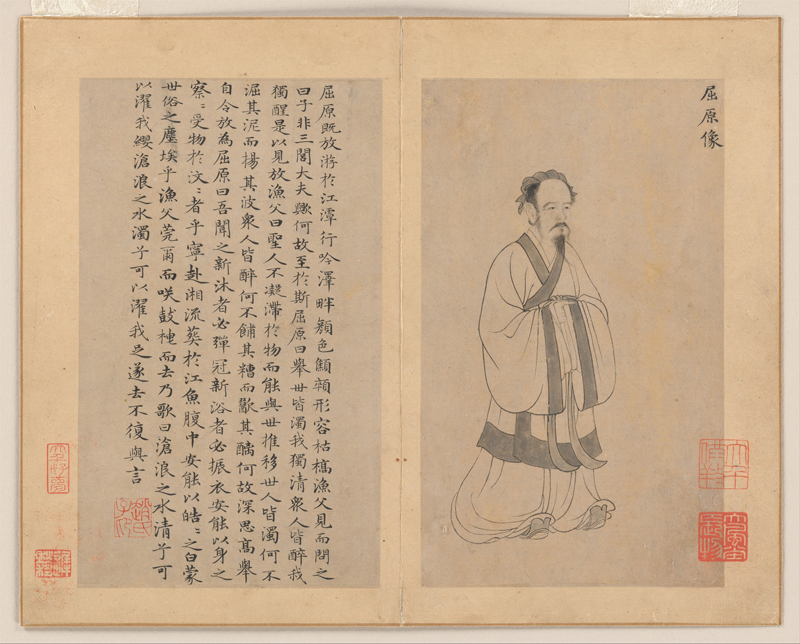端午节: Dragon Boats, Drowning, Dumplings, Demons and Disease
8 Essential Things to Know About the Dragon Boat Festival!
Think you know all about the Dragon Boat Festival? Dumplings, dragon-shaped boats and poets tossing themselves into rivers? There’s so much more to it!
1. It’s not actually the “Dragon Boat Festival”
The proper name for the ‘Dragon Boat Festival’ is the Duanwu Festival 端午节 (Duānwǔ jié), which is celebrated on the fifth day of the fifth month of the lunar calendar.
The word 端 (Duān) comes from 开端 (kāiduān), which means “beginning”.
端五 ((Duān wǔ; the start of the fifth month) somehow evolved into 端午 over the years.
Duanwu also has other names, which include:
- 端阳节 (duānyáng jié) or 端日节 (duān rì jié)—both of which can be translated as “Start of the Sun Festival”
- 重午/重五 (chóng wǔ)—Repetition of Noon or 5th (because it’s the fifth day of the fifth month)
- 五月节 (wǔ yuè jié)—May Festival
- 五日节 (wǔ rì jié)—5th Day Festival
- 午日节(wǔ rì jié)—Noon Day Festival
- 夏节 (xià jié)—Summer Festival
- 天中节 (tiān zhōng jié)—Mid-Sky Festival
- 菖蒲节 (chāngpú jié)—Calamus (a kind of root vegetable) Festival
- 艾节 (ài jié)—Mugwort/Wormwood (a herb) Festival
- 粽子节 (zòngzi jié)—Rice Dumpling Festival
Phew!
2. Disease and Demons
Do NOT wish people “端午节快乐“ (Happy Duanwu Festival).
Instead, wish people
端午节安康
(Duānwǔ jié ānkāng)
“May you have a peaceful and healthy Duanwu Festival”
This is because since ancient times, this period is considered a time of really bad luck—associated with disease brought by demons.
In fact, there’s even a saying: 「端午节,天气热,五毒醒,不安宁。(Duānwǔ jié, tiānqì rè, wǔ dú xǐng, bù ānníng.)」which translates as “At the Duanwu Festival, the weather gets hot, the 5 poisons awake, and there is no peace.” Traditionally, the ‘5 poisons’ are snakes, scorpions, centipedes, toads and either lizards or spiders.
So it sounds like back in the day, people got sick a lot at the start of the summer months, when the change in weather brought out all sorts of bugs…)
In many places, folks would paste colourful paper cuttings of the 5 poisons onto walls and doors to ward off disease.
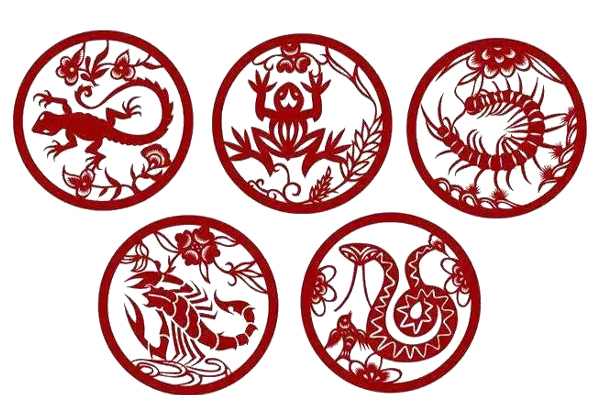
Images of the 5 poisons are also woven into garments and ornaments.
Plants with medicinal or insect-repelling qualities like vanilla, calamus, mugwort, angelica and gardenia flowers are also packed into sachets called 香包 (xiāng bāo) and are hung up, attached to children’s clothing, added to bathwater, and in some places, used to brew tea.
The designs can be very pretty! You can even make your own:
3. Drowned Dude
The most famous legend associated with Duanwu is the sad tale of 屈原 (Qū Yuán, 340–278 BCE), a poet and advisor to the king of the state of 楚 (Chǔ) during the Warring States Period (战国时代 zhàn guó shí dài), 475–221 BCE, which involved fighting between seven or more small kingdoms.
Qu Yuan advised the King of Chu to team up with the other states to fight against the strongest state—秦 (Qín).
But officials who were jealous of Qu Yuan said nasty things about him to the King of Chu, and poor Qu Yuan was accused of treason and sent into exile, where he wrote a lot of sad poems.
His most famous work is 离骚 (Lí Sāo), which literally means “Upset at Leaving”, so you get the idea. It’s super-long, but if you’re curious enough, here’s a video of the entire poem being read—together, helpfully, with English annotations.
Anyway, Qu Yuan turned out to be right—the Qin eventually conquered all the warring states and established China’s first unified empire.
When the Qin conquered the Chu (legend has it on the 5th day of the 5th month), Qu Yuan was so heartbroken that he drowned himself in the Miluo River ( 汨罗江 Mìluójiāng (a tributary of the Yangtze), so that he would perish along with his home country.
According to the legend, the common folk so loved Qu Yuan that when they heard he’d thrown himself in the river, they raced out in boats, banging drums and throwing rice dumplings into the water so that the fish would eat the rice and leave Qu Yuan’s body alone.
And hence, we commemorate Qu Yuan on Duanwu by racing dragon boats and eating rice dumplings.
Uh, actually not quite.
4. Dragon Boats Pre-Date Drowned Dude
More recent historical research indicates that 龙舟比赛 (Lóngzhōu bǐsài) dragon boat racing actually existed before Qu Yuan or Duanwu.
It’s believed that it’s a ritual descended from the 吳越族 (Wúyuè zú), an ancient ethnic group who lived on the banks of the Yangtze, that may be the ancestors of Southeast Asian peoples like the Malays and Vietnamese.
Whatever the true origins, racing in long dragon-headed boats to rhythmic drums is a colourful and integral part of Duanwu, and races are held in many Chinese communities. You might even have a team in your hometown that you can join!
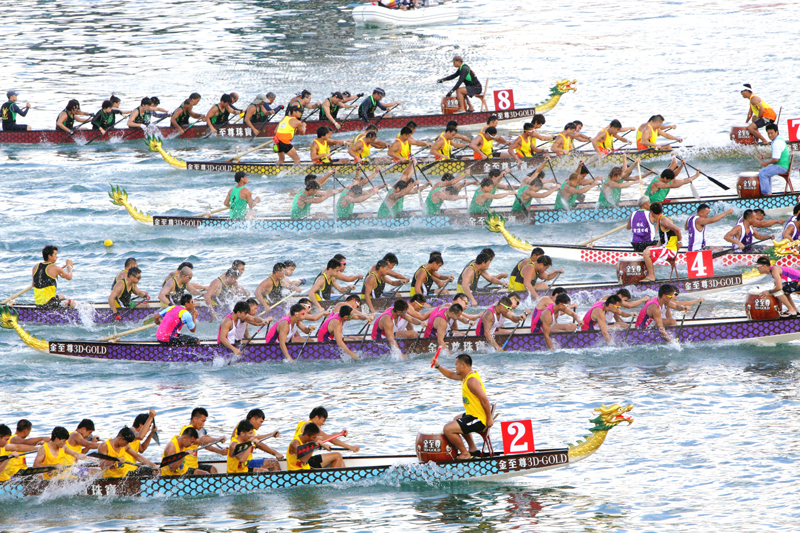
5. Rice Dumplings—ZOMG! Zongzi!
粽子Zòngzi—often called ‘rice dumplings’ in the West or some variation of “bak chang (肉粽)” in Southeast Asia—are a quintessential part of Duanwu, even though Chinese people eat these packets of rice and various ingredients wrapped in leaves year-round nowadays, not just at Duanwu, and actually have done so for millennia.
Of course, zongzi come in many variations, depending on ethnicity, history and ingenuity.
Here is just a small sampling of common zongzi:
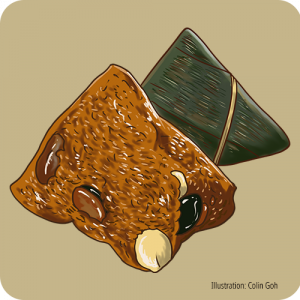
福建肉粽
Fújiàn ròu zòng
Hokkien Bak Chang
Common in Singapore, Malaysia and Southeast Asian Chinese communities with Fujianese ancestry, it is filled with pork belly, chestnuts, mushrooms, dried shrimp, and sometimes salted egg yolks and gingko nuts, enclosed by rice coloured by dark soy-sauce.
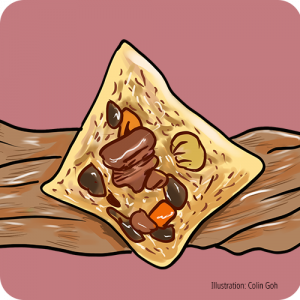
台湾北部粽
Táiwān běibù zòng
Taiwan Northern Zongzi
The Hokkien bak chang’s Taiwanese cousin. Pork belly, dried shrimps, mushrooms, chestnuts, and sometimes salted egg-yolk, stir-fried then wrapped in bamboo leaves before steaming.
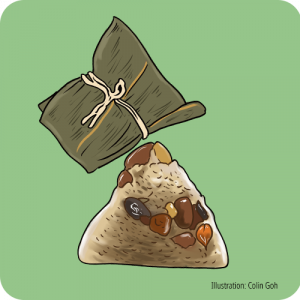
台湾南部粽
Táiwān nánbù zòng
Taiwan Southern Zongzi
Similar to the Northern zongzi, except it also contains peanuts in addition to pork belly, dried shrimps, mushrooms, chestnuts and salted egg-yolk. It is cooked by boiling rather than steaming.
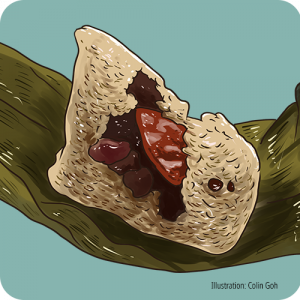
广东粽子
Guǎngdōng zòngzi
Cantonese Zung Zi
Common in Cantonese communities, these zongzi are filled with a mix of fatty pork and lean meat, together with green beans or split mung beans, and Chinese sausage. The glutinous rice is seasoned with garlic oil and salt.
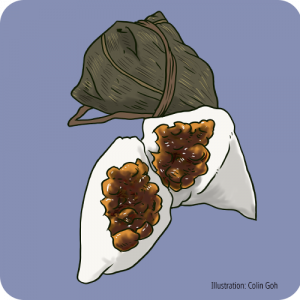
客家粄粽
Kèjiā bǎn zòng
Hakka Ban Zang
Glutinous rice is pounded to a paste before enclosing pork, dried shrimp, mushrooms, and dried radish. Once wrapped in bamboo leaves, it is steamed.
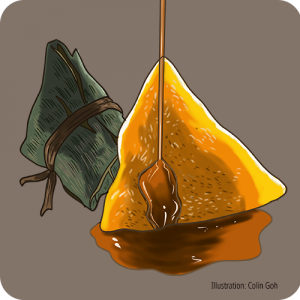
客家碱粽
Kèjiā jiǎn zòng
Hakka Kee Zang/Alkaline Zongzi
Often served without fillings (but drizzled with sugar syrup), this zongzi’s distinctive yellow glutinous rice comes from lye water (枧水 Jiǎn shuǐ), an alkaline mix which gives ramen noodles their springy mouthfeel, and bagels, pretzels and traditional Cantonese mooncakes their dark golden colour.
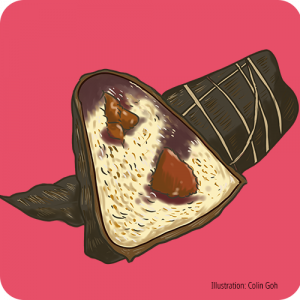
潮州肉粽
Cháozhōu ròu zòng
Chaozhou zongzi/Teochew Bak Chang
In addition to the usual glutinous rice, pork belly, mushrooms and dried shrimp, the Teochews add either red date or lotus paste to yield a combination of sweet and savoury flavours.
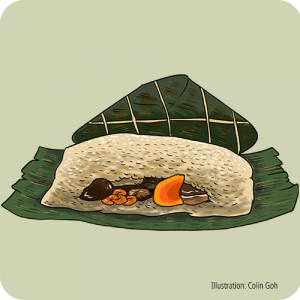
海南枕头粽
Hǎinán zhěntou zòng
Hainanese Pillow Zongzi
Barbecued pork (or sometimes even chicken wings), salted egg yolk, salted fish and glutinous rice, shaped into a pillow and then wrapped in either banana leaves or osmanthus leaves before boiling.
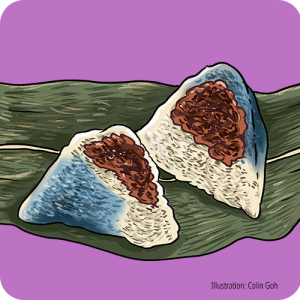
娘惹肉粽
Niáng rě ròu zòng
Nonya Bak Chang
A blend of Malay and Chinese influences, Nonya changs contain a mix of fatty and diced pork, mushrooms and candied winter melon, flavoured with coriander powder (ketumbar) and pandan leaves. The rice is also tinged with blue from the butterfly pea flower.
6. More Sad, Soggy Sources
Qu Yuan wasn’t the only possible source of the Duanwu legend!
Another candidate was 伍子胥 (Wǔ Zǐxū), who lived nearly 200 years before Qu Yuan. Just like Qu Yuan, Wu tried to warn his king about the dangers posed by another state. Angered , the king ordered Wu to commit suicide, then tossed his body into the river. Some places, such as Suzhou, commemorate Wu Zixu during Duanwu, and he is also worshipped as a sort of river god in parts of Eastern China.
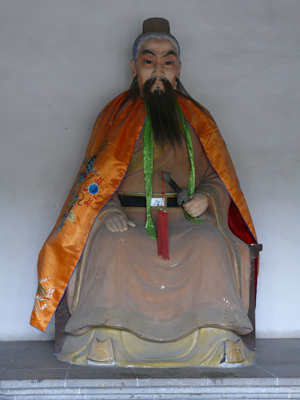
A statue of Wu Zixu in a temple in Suzhou in Jiangsu province, China.
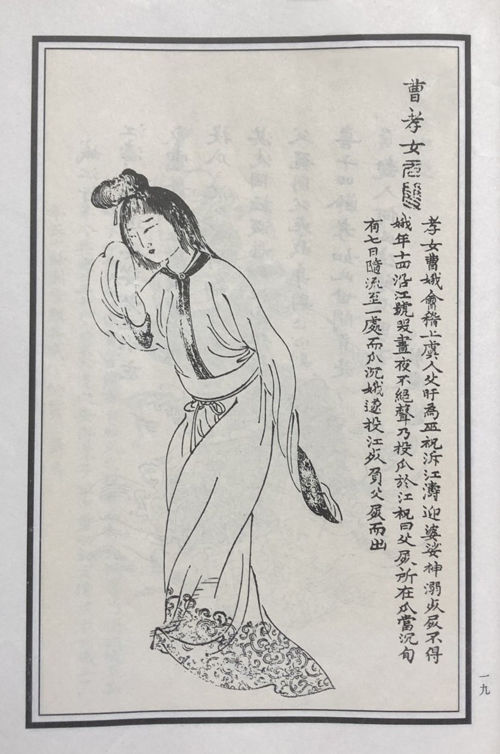
Cao E (曹娥) as depicted in the 无双谱 (Wúshuāng pǔ, the Table of Peerless Heroes) circa 1694.
If you want to draw a common thread, Duanwu is about honouring virtuous people who met tragic ends in bodies of water.
7. Balance an Egg at Noon!
Rowing dragon boats not your cup of tea? Try balancing an egg on its end!
Legend has it that if you can balance an egg on its end at exactly 12 noon on Duanwu, you’ll be rewarded with good luck in the coming year.
In places like Taiwan, Foshan and Fujian, there are even egg balancing contests!
The origins of the game are unclear, but science has established that it is possible to balance an egg at times other than 12 noon on Duanwu! Still fun, though—if you have a few eggs to spare!
8. It’s Not Just Celebrated by the Chinese!
Other countries that celebrate Duanwu (or some variation of it) include:
Japan: The Japanese celebrate 端午の節句 Tango no Sekku on May 5th, where families with sons hang flags in the shape of carps, who are seen as courageous. They also eat leaf-wrapped mochi made from grated rice, rather than glutinous rice. There is a large dragon boat race in Okinawa at this time too.
Korea: The Koreans celebrate 단오 Dano, which is derived from Duanwu, on the same day, though their festivities don’t include dragon boats or dumplings. Rather they play swing games, wrestle and eat herb rice cakes.
Vietnam: The Vietnamese celebrate Tết Đoan Ngọ on the same day with dragon boat races and Banh tro—pyramid-shaped glutinous rice cakes stuffed with mung bean paste, wrapped in banana leaves.
Cambodia: Cambodians race dragon boats during Bon Om Touk (lit. “Boat Racing Festival”, also known as the Cambodian Water Festival) around the lunar Mid-Autumn Festival.
Laos: The Lao race boats decorated like naga (half-human, half-dragon spirits) during Boun Xuang Heua (boat racing festival) also around the lunar Mid-Autumn Festival.
Of course, ethnic Chinese communities outside China, like those in Singapore, Malaysia, the US, Australia and the UK, also celebrate the festival.
We hope you found this guide useful! Now go find some zongzi to eat! They’re now available year-round—not just at Duanwu!
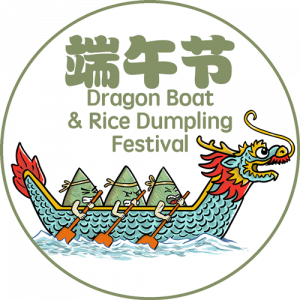
Thanks to everyone who attended our 端午节 (Dragon Boat Festival) Doodle Date on 4th June! We had participants from Singapore, Malaysia, Taiwan, Thailand, Australia and the US. Auntie Yen Yen, Uncle Colin and Teacher Hsiao would like to thank the Chen family in Yunlin County for letting us visit them as they were making special 5-grain 粽子 (rice dumplings), and special guest Teacher Alice who told us so much about 龙舟 (dragon boats)! And we had a blast telling the story of 屈原 Qu Yuan with handmade paper puppets! If you missed it, catch the recap here.
Didn’t register in time? Want to get alerts about our upcoming events and Doodle Dates?
Register for a Username and Password for FREE!
(You’ll also get a FREE basic subscription to our award-winning App!)

